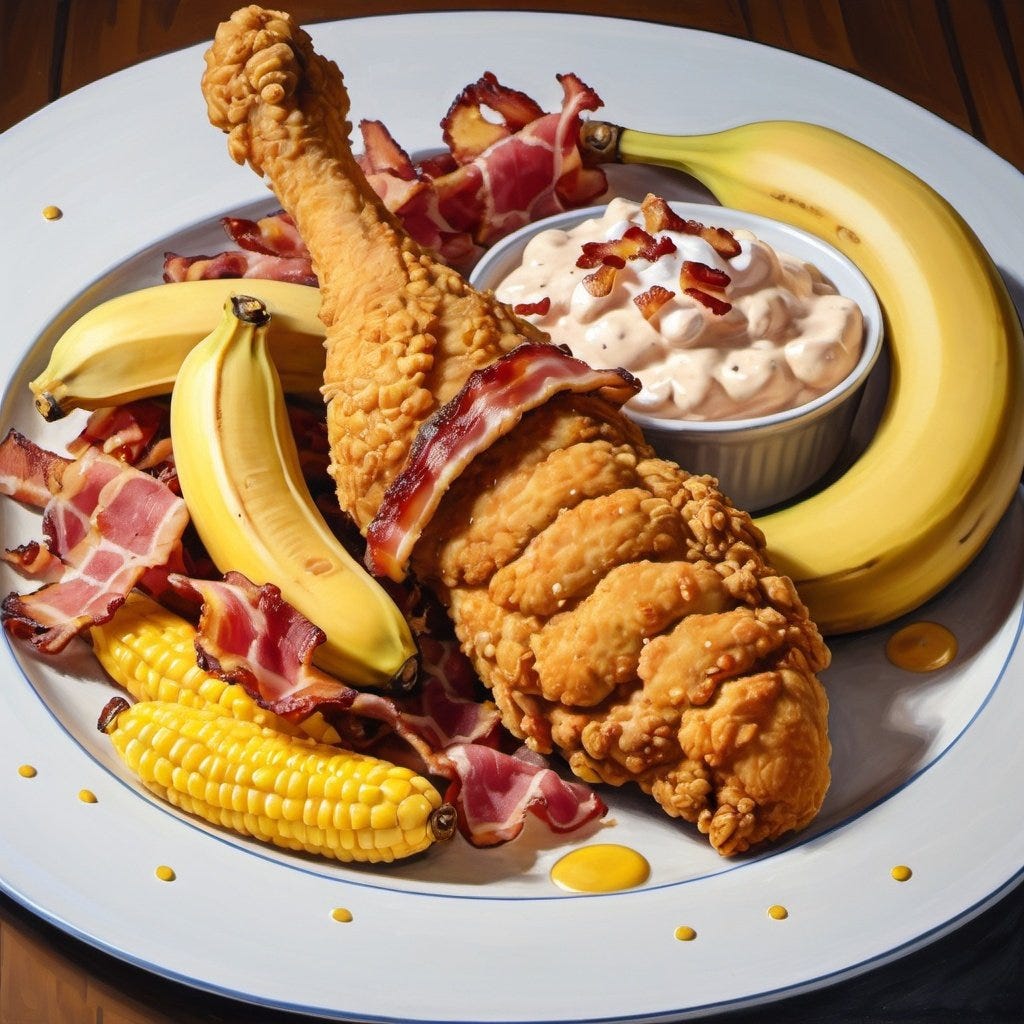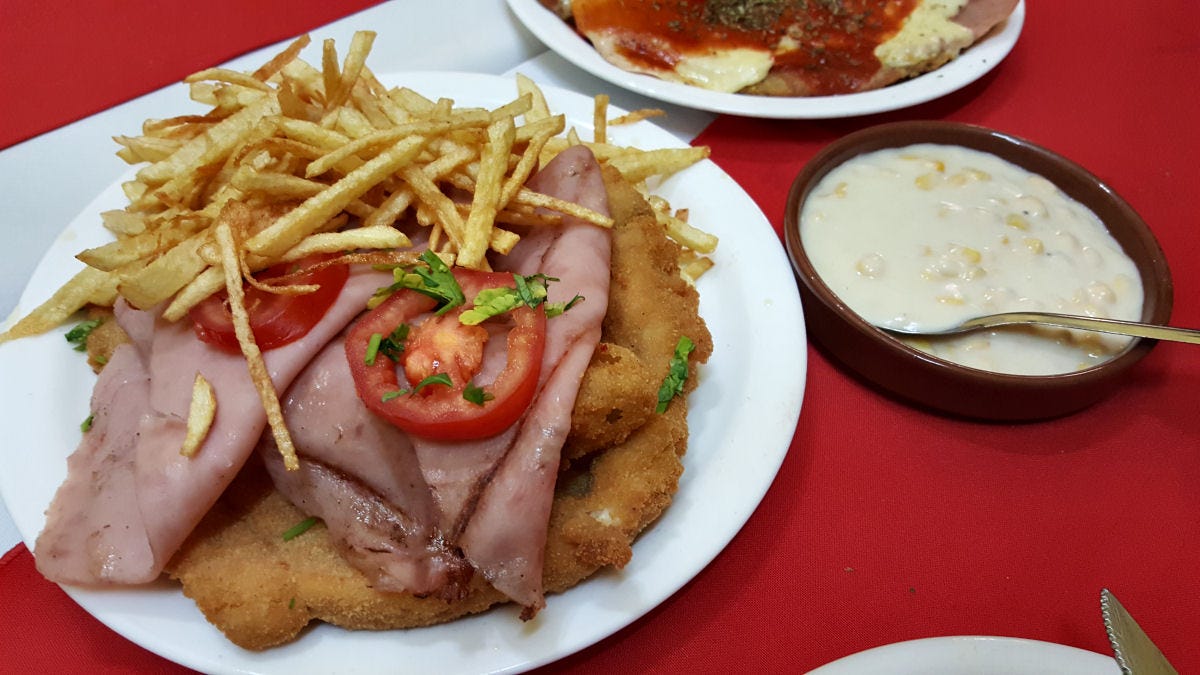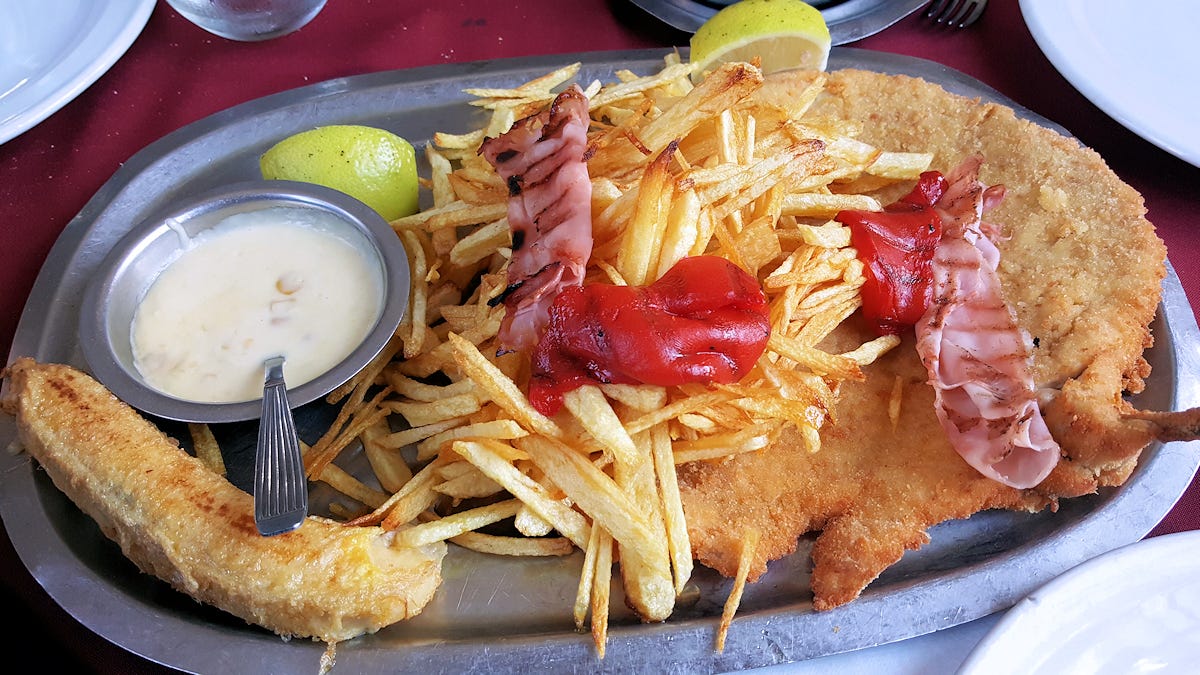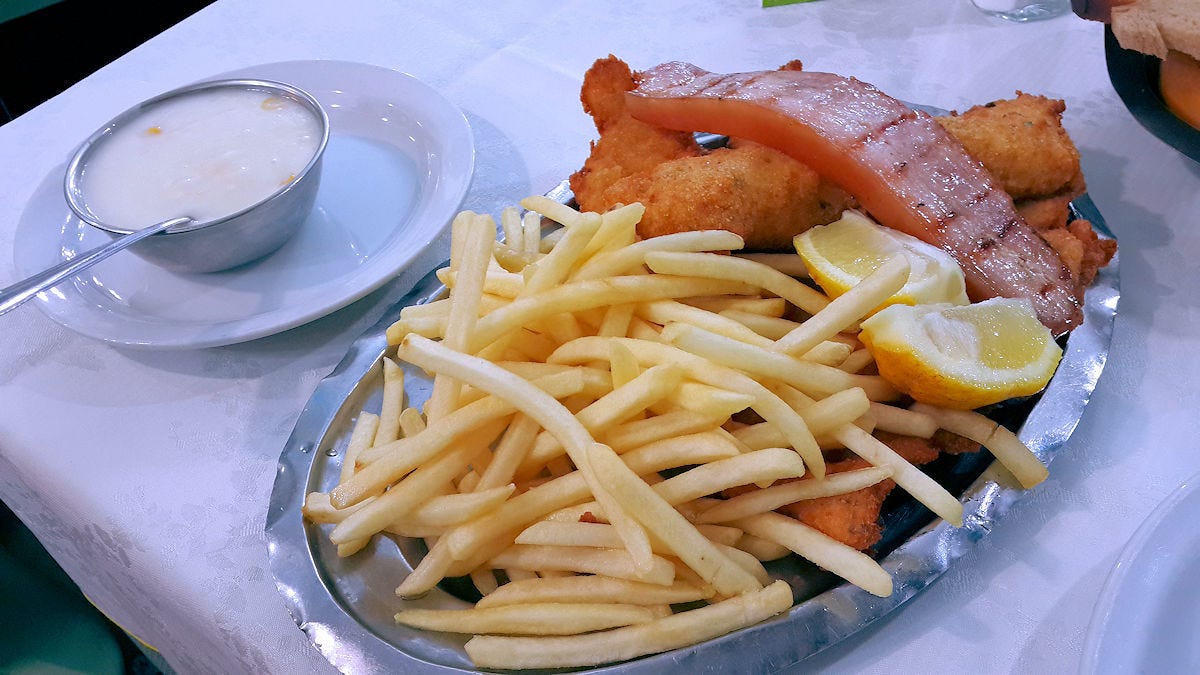There's Something About Mary-Land
An Argentine "classic" reinvention
Sometimes, there’s an oddball dish that catches my attention, and I find myself filled with the need to explore it further. The dish that has caught my attention, on and off since I moved here, is Pollo Maryland (Chicken Maryland), or Suprema Maryland, a few folk throw in “a la” before the Maryland. I’m going to start with what I can find out about its origins.
It seems to have started in the US state of Maryland. It’s one of those recipes that stretches back far enough that there’s no official recipe, it’s more or less “the way fried chicken was made in Maryland, different from southern fried chicken”. There seem to be two ways to go that make it different, much of which may just have depended on whether person making it had an oven or how much work it was to fire it up – the chicken pieces (often, but not always, marinated in buttermilk) are simply dredged in flour and then shallow pan fried in either butter or lard until brown (never deep fried) – at that point, the pan is either put in the oven to finish cooking the chicken through, or, covered, leaving the chicken to steam in its own juices. The chicken is then served with a white pan gravy made from the drippings in the pan and the addition of either milk or cream. And that seems to be about as far as the “classic” goes.
As best I’ve been able to find, the first time the dish appeared in print as a standard recipe was in the 1896 edition of the Boston Cooking-School Cook Book, what later became the The Fannie Farmer Cookbook – Farmer’s version was an attempt to cut down further on fat, which she upfront admitted, so she used butter in place of lard, but just enough to baste the chicken (dredged in flour) while it baked in the oven, rather than fried atop the stove, and then created a cream sauce to go with it – how that reduced the fat from using lard, I’m not really clear.
Just a few years later, in 1908, apparently, Auguste Escoffier tried a version of the dish at a restaurant called Martin’s, in New York, fell in love with it and went back to London to tinker with the idea. He included a version of it in his Ma Cuisine in 1934 – dredging the chicken in flour, then in beaten eggs, and then in breadcrumbs, fried it in butter, and served it accompanied by sweet corn fritters, potato croquettes, broiled bacon (not pan fried), and bananas fried in butter (without a crust), and then topped the whole thing with a horseradish bechamel or, as an option, with a garlic and parsley infused tomato sauce.
Not surprisingly, since Escoffier introduced his version there, this tends to be the version of Chicken Maryland that is served in the UK. And the fabled encyclopedia of French cooking, Larousse Gastronomique, began to include a version of the dish, Poulet frit Maryland that was fried chicken coated in a milk, onion, garlic, and giblet gravy and served with bacon, grilled corn on the cob or corn fritters, and a fried halved banana. Worth noting, this version of the dish was on the menu for the last dinner on the Titanic before it went down. Just sayin’. As an aside, the term “chicken maryland” in Australia has nothing to do with a specific dish, but is simply what the cut of a thigh and drumstick together is called in a butcher shop.
Wikipedia reports on a southeast Asian version that’s served with “hush puppies” and deep fried potatoes, carrots, tomatoes and bananas. Though, the closest thing I’ve found searching on my own is chicken served with tod man kao pod, which are delicious rice flour and fresh corn fritters, but none of the rest of Wikipedia’s claimed dish.
Here in Argentina, the version is a bit closer to the Escoffier style than the original American style. It’s classically a pounded thin boneless breast of chicken, often with the first joint of the wing still attached (bone left in on that, so it looks a bit like a cutlet), breaded and fried, and served with a breaded and fried whole banana, a slice of ham or bacon, and creamed corn, or at least a bechamel sauce with corn in it, and, of course, french fries, because everything here is served with french fries….
Just for fun, I described the dish to, respectively, OpenAI and Google Gemini image creators (because it’s all the rage these days), to see what they’d come up with. These were the best, and arguably closest, of the images they came up with. Google, by the way, refused to provide either a “picture” or “image” of the dish, stating that that wasn’t its purpose, but was happy to provide a “painting” of it, which is actually not far off of the actual dish. The less said about the OpenAI version, the better.
All this leads to, of course… “if I’m visiting Buenos Aires, where can I try this (choose one: amazing combination / abomination)? I can’t claim to have tried every version of the dish in town, but I’ve tried an inordinate number of them, and I’ve picked out some favorites - let’s count up from number five to number one!
La Tasca de Fósforita, Av. Hipólito Yrigoyen 1218, Monserrat. Of the five spots I’m going to make note of, this is the easiest to get to for most visitors, being in the center of town. It’s an old-school bodegon, which one might loosely define as a place, usually family run, serving classic local dishes, and often known for one or two particular dishes that they do exceptionally well. Oh, and kitsch is the décor of choice and the vast majority. One of the better versions I’ve had, an excellent cutlet with a well seasoned breadcrumb crust, the ham is grilled, which gives it a nice texture and smokiness, fresh tomatoes - an unusual addition, a good sized ramekin of the creamed corn sauce to smother it in, and a decent fried banana. Also, the papas pailles that it came with were perfectly crispy, if a touch oily.
Restaurante Larreta, Mendoza 2369, Belgrano. Old school Argentine spot, with all the classics on their menu. White tablecloths, waiters who’ve been there since Argentina was founded…. Their claim to fame is their selection of a dozen different supremas, or chicken milanesas – breaded and fried chicken breasts, with various creative toppings. First off, the suprema itself, superb. A large, whole chicken breast, with the wing drumette still attached. Juicy, well seasoned, and with a beautiful crunchy breadcrumb exterior. The classic fried banana is done just as well, the whole thing draped with a thick slab of caramelized bacon, and then accompanied with a generous portion of sweet creamed corn, and the most corn-filled version I’ve found, and crispy, thin, shoestring potatoes.
El Puentecito (“The Little Bridge”), Vieytes 1895, Barracas. Although more than one local opined to me that this is the best version out there, for me it comes in third. It’s a very good version of the dish, with a perfectly golden cooked chicken cutlet, the ham slices, albeit still lunchmeat, have been grilled, as have the bell peppers. The banana is only lightly coated with crumbs, rather than being battered, and isn’t mushy. The creamed corn was more cream than corn, but still tasty. And I like that they went with papas pays, shoestring potatoes. The location is definitely off the beaten track for visitors.
Gambrinus, Federico Lacroze 3779 in Chacarita. In town, this is far and away my favorite version of the dish. The restaurant is an ostensibly German one, so it’s not surprising, perhaps, that a hearty dish like this would be adopted onto the menu. The food is really more German-influenced Argentine. Here, a thick, whopping cutlet of chicken is crunchy and golden, as is the banana in the same crumb coating. Instead of ham, a generous slab of grilled bacon is added atop, and out of sight under the quite good french fries, is a whole roasted bell pepper. The creamed corn, again, a bit more cream than corn, but very good. And the place is well situated for a visit to a lesser known tourist attraction, the Chacarita Cemetery, which to my mind is far more interesting than the more famed Recoleta one, plus has separate sections for “German” (i.e., Lutheran), “British” (i.e., Anglican), and Jewish burials.
Aquiles, Av Bartolomé Mitre 298, Villa Martelli. Far and away the best version of this dish I’ve ever tried, this one requires a bit of a train trip to just outside the city in the northern suburbs. When it arrived I just sort of gawked at it. It was enormous – an entire boneless chicken breast – not just one side, the whole thing, covered the plate, with a mound of fries, a fried banana, ham, bacon, peas, roasted bell pepper, and instead of the usual bechamel sauce with a bit of corn in it, a whopping smothering of creamed corn, and the whole thing topped with a perfectly fried egg. And you know what? It was spectacular.
Now, while these are my five favorites, there are plenty of quite good versions out there, and thankfully, at least so far, very few bad ones. So if you see it on the menu, and are feeling hungry and mildly adventurous, give a Suprema Maryland a shot!









The last one I had was at Fraga Bodegón. Very tasty but I haven’t tried enough consistently to compare to others.